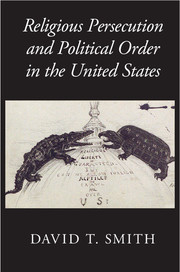Book contents
- Frontmatter
- Dedication
- Contents
- Acknowledgments
- 1 Introduction
- 2 Religious freedom and persecution in America: A theoretical overview
- 3 Joseph Smith and the rise of Mormonism: The political threat of religious charisma
- 4 The federal response to Mormonism
- 5 Jehovah's Witnesses and the flag salute, 1870–1940
- 6 Mass violence against Jehovah's Witnesses, 1940–1942
- 7 The Catholic experience in America
- 8 The Jewish experience in America
- 9 The Islamic experience in America
- 10 Conclusion
- Sources and bibliography
- Index
5 - Jehovah's Witnesses and the flag salute, 1870–1940
Published online by Cambridge University Press: 05 November 2015
- Frontmatter
- Dedication
- Contents
- Acknowledgments
- 1 Introduction
- 2 Religious freedom and persecution in America: A theoretical overview
- 3 Joseph Smith and the rise of Mormonism: The political threat of religious charisma
- 4 The federal response to Mormonism
- 5 Jehovah's Witnesses and the flag salute, 1870–1940
- 6 Mass violence against Jehovah's Witnesses, 1940–1942
- 7 The Catholic experience in America
- 8 The Jewish experience in America
- 9 The Islamic experience in America
- 10 Conclusion
- Sources and bibliography
- Index
Summary
INTRODUCTION
When Jehovah's Witnesses suffered mass public violence in the 1940s, observers drew parallels between their ordeal and that of the Mormons. But despite their shared experience of persecution, Jehovah's Witnesses were very different from Mormons and were persecuted in very different ways. While the federal government sometimes targeted Jehovah's Witnesses – most notably after America's entry into each World War, when Witnesses were imprisoned for refusing to be conscripted – the most violent persecutions of Jehovah's Witnesses occurred with passive rather than active state involvement. At the local level, police and sheriffs often allowed assaults and intimidation to take place, sometimes coming to the assistance of Witnesses but other times helping their antagonists. At the federal level, the government condemned the persecution of Jehovah's Witnesses but did almost nothing to stop it.
Jehovah's Witnesses, unlike Mormons, never aspired to create a new polity, and actively avoided political involvement. While the Mormons were a national obsession in the nineteenth century, Jehovah's Witnesses were barely known or understood in the twentieth. As I will show over the next two chapters, the threat they posed to political order was symbolic rather than material. They posed no challenge to state sovereignty, but by refusing to salute the American flag they disrupted a ritual of national unity and consensus. This made them powerful enemies in civil society, especially the American Legion, for whom the flag salute was an important affirmation of the social and political status of war veterans. Local law enforcement agencies, as I will show in the following chapter, had little reason to side with Jehovah's Witnesses over the American Legion in their communities.
In Chapter 6 I explore the patterns of mass violence against Jehovah's Witnesses and explain the state response to it. In this chapter I trace the historical trajectory of Jehovah's Witnesses and the origins of the conflict that led to the spectacular persecution of the 1940s. While the flag salute conflict came to define the experience of Jehovah's Witnesses in the 1940s, it was not the only point of tension between them and broader society. Witnesses were openly hostile to the Catholic Church, and they expected to be persecuted for this reason, but this kind of religious conflict never eventuated. I show why the flag salute in particular became the issue that turned civil society against Jehovah's Witnesses, largely because of the involvement of the American Legion.
- Type
- Chapter
- Information
- Publisher: Cambridge University PressPrint publication year: 2015



